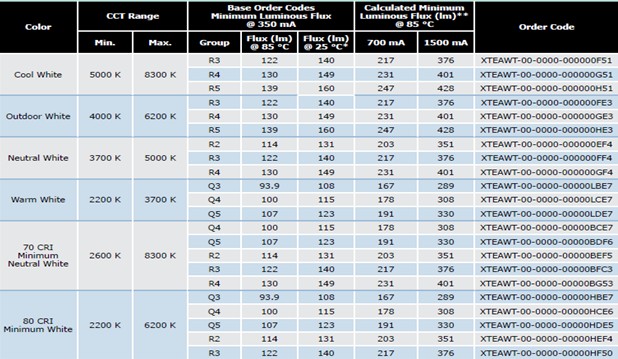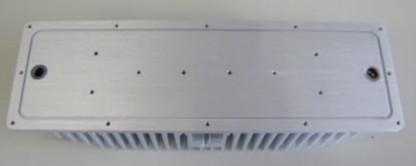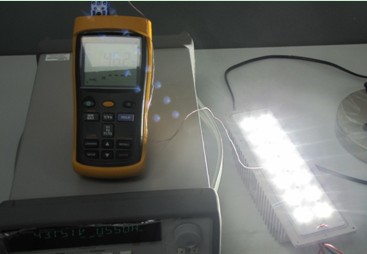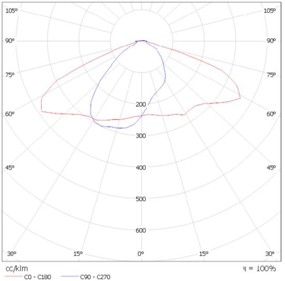With the wide application of LED lighting, for the field of LED road lighting, Cree currently introduces XM series, XP series, XT series, XB series, CXA series and other cost-effective lighting-level LED products, fully satisfying customers' positioning for different markets. Product design needs to help customers achieve lower system cost and higher lighting performance products and solutions. This article will share Cree's lighting-class XT series LED and road lighting reference solutions, while Cree looks forward to more technical exchanges with industry peers in the future. CREE Career promotes the popularization and application of LED lighting through persevering innovation, and implements the mission of Cree, leading the LED lighting revolution, eliminating low-energy lighting, and fully accelerating the wide application of LED lighting. Cree's LED-leading technology helps to achieve significant energy-saving effects on road lighting, and fully meets national road lighting standards in terms of light efficiency, brightness, illumination, heat dissipation, and longevity, achieving faster return on investment, and brand and knowledge. The property rights advantage protects customers and helps customers lead the market. Technology leadership will better promote market leadership and help companies achieve stronger growth in LED lighting revolution. Cree XLamp ® XT Series LEDs are based on the revolutionary SC ® technology platform, featuring next-generation silicon carbide DA (Direct Attach) chips, optimized heat dissipation packages and new phosphors for higher luminous flux and efficacy and better reliability Combines high light output, high reliability and high light efficiency. XLamp ® XT-E LEDs offer twice the price/performance ratio (lm/$) of other LED products and the industry's highest performance and efficacy, virtually eliminating the biggest barrier to large-scale LED lighting applications. Available in a conventional 3.45mm x 3.45mm XP package, the XLamp ® XT-E LED can be used in almost any lighting application. Based on the XP package structure, customers can easily combine XLamp ® XT-E LEDs with existing XLamp ® XP LED designs to shorten LED luminaire design cycles and speed time-to-market. Generally speaking, outdoor lighting requires high luminous efficiency, high luminous flux, high maintenance characteristics, etc. In addition, it requires more safety protection than indoor lighting, and requires better performance in terms of life and reliability. Light efficiency, optical communication, excellent light color quality, longevity and reliability are the advantages of the Cree XLamp ® series. For the various street lighting products on the market, the high-efficiency series XLamp ® XT-E devices are shared and discussed with the lighting manufacturers or designers in the actual case of some module solutions and customer applications in street lighting applications. XLamp ® XT series is a fine LED of Cree. According to some requirements of single power or low color temperature, we have made different color temperature and different light efficiency requirements. Based on good performance, longevity and color coordinate stability, as well as high cost performance and other factors, this design uses 3000K/4000K/5000K color temperature, Q5/R3/R4 file. Figure 1. XLamp ® XT-E LED brightness and color temperature selection XLamp ® XT-E LEDs have been tested with the LM-80 to meet ENERGY STAR requirements, which provide a good foundation for safe and reliable street lighting design. XLamp ® XT-E LEDs are Cree's intellectual property LEDs, which comply with the patent regulations of various countries in the world and can be sold in any country. Figure 2. XLamp ® XT-E LED outline and its footprint Due to the improvement of the luminous efficacy of LED lamps, the proportion of heat is decreasing, but 60~70% of the input energy is converted into heat, and the rest is converted into light. Therefore, a heat dissipation system is needed to ensure long-term reliable operation of the lamps, so we choose the following accessories. To help LED heat dissipation. Figure 3. High thermal conductivity MCPCB Figure 4. Heat sink structure Figure 5. Solder joint temperature test Through the physical test, the solder joint temperature of this reference design is about 46.4 degrees, and the calculated Tj is about 55 degrees. In terms of optics, we use an integrated lens solution to complement our street light module design. With Redick street light lens (LL14CR-AOC65150L02), the optical efficiency can reach more than 93%. Figure 6. Street light lens Through the combination of six components such as heat dissipation and optics, we have made street lamp modules including LED devices, aluminum substrates, heat sinks, optical lenses, and waterproof parts. Figure 7. Street light module Figure 8. Street light module and light distribution curve The measured data is as follows: Table 1. Measured data for XLamp ® XT-E LED street light module The test results show that the three XLamp ® XT-E LED street light module design solutions can achieve 85 lm / W, R4 can exceed 100 lm / W, modular design makes the structure simple, easy to assemble, can High-quality street lamp design that meets different color temperature and light efficiency requirements. A comprehensive selection of USB connectors are available with various combinations of form factors, interface and version types, vertical and horizontal configurations, as well as a unique new USB 2.0 Type-C charging option. Chances are Antenk have the right USB Connector for you. USB Connector USB A-Type Connector, USB B-Type Connector, USB Type-C Connector, Micro-USB A Connector, Micro USB B Connector, USB Mini-b (5-pin) Connector, USB Mini-b (4-pin) Connector, USB 3.0 A-Type Connector, USB 3.0 B-Type Connector, USB 3.0 Micro B Connector ShenZhen Antenk Electronics Co,Ltd , https://www.antenk.com








USB (Universal Serial Bus) was originally developed and introduced in 1996 as a way of setting up communication between a computer and peripheral devices by replacing many varieties of serial and parallel ports.
USB connectors have become the standard connection method for devices such as mice, keyboards, game pads & joysticks, scanners, digital cameras, printers and external hard drives.
Although designed for personal computers USB has become commonplace on other devices such as mobile phones, PDA's, video game consoles, AC power adaptors, memory sticks and mobile internet access dongles.
USB Connector Type
USB Type A
Also known as USB standard A connector, the USB A connector is primarily be used on host controllers in computers and hubs. USB-A socket is designed to provide a "downstream" connection intended for host controllers and hubs, rarely implemented as an "upstream" connector on a peripheral device. This is because USB host will supply a 5V DC power on the VBUS pin. As such, it is important to remember while purchasing USB cables it is safest to make sure at least one of the plugs is a USB A.
Though not that common, USB A male to A male cables are used by some implementers to make connections between two USB A style female port. Be aware that typical A-A cables are not intended for connection between two host computers or computer to hub.
Related Products:
USB 2.0 A to A Female Cables
USB 2.0 A to B Cables
USB 2.0 A to Mini B Cables
USB 2.0 A to Micro B Cables
USB 2.0 A to A Angle Cables
USB 2.0 A to B Angle Cables
USB 2.0 A to Mini B Angle Cables
USB 2.0 A to Micro B Angle Cables
USB 2.0 A to B Locking Cables
USB 2.0 A to Mini B Angle Cables
USB 2.0 A Female to A Cables
USB 2.0 A Female to Crimp Housing Cables
USB 2.0 A to B High Flex Cables
USB 2.0 A to C Cables
USB Type B
Also known as USB standard B connector, the B style connector is designed for USB peripherals, such as printer, upstream port on hub, or other larger peripheral devices. The primary reason for the development of USB B connectors were to allow the connection of peripheral devices without running the risk of connecting two host computers to one another. USB B type connector is still used today, though it is slowly being phased out in favor of more refined usb connector types.
Related Products:
USB 2.0 A to B Cables
USB 2.0 A to B Angle Cables
USB 2.0 A to B Locking Cables
USB 2.0 A to Mini B Angle Cables
USB 2.0 B Female to B
USB 2.0 B Female to 5 Pin Cables
USB Type C
USB-C or USB Type-C Connector is the newest USB interface came to the market along with the new USB 3.1 standard. Different from previously mentioned USB A type and B type connector, USB C Type connector can be used on both host controller ports and devices which use upstream sockets. In the last few years a numbers of laptops and cellphones have appeared on the market with C style USB connectors.
USB Type C connector is compatible with USB 2.0, 3.0, 3.1 Gen 1 and Gen 2 signals. A full feature USB 3.1 Gen 2 C to C cable is able to transmit data at maximum 10 Gbps with enhanced power delivery of up to 20V, 5A (100W) and to support DisplayPort and HDMI alternate mode to transfer video and audio signal.
Related Products:
USB-C to USB-C Cables
USB 3.0 to USB-C Cables
USB Mini B
Similar to USB B type connector, USB mini B sockets are used on USB peripheral devices, but in a smaller form factor. The mini B plug by default has 5 pins, including an extra ID pin to support USB On-The-Go (OTG), which allows mobile devices and other peripherals to act as a USB host.
Initially, this plug was designed for earlier models of smartphones, but as smartphones have become more compact and with sleeker profiles, the Mini USB plug has been replaced by the micro USB. Now, the Mini-B is designed for some digital cameras while the rest of the mini plugs series have become more of a legacy connectors as they are no longer certified for new products.
Related Products:
USB 2.0 A to Mini B Cables
USB 2.0 Mini A to Mini B Cables
USB 2.0 Mini B to Mini B Cables
USB 2.0 Mini B to Mini B Female Cables
USB 2.0 Mini A to Mini B Angle Cables
USB 2.0 A to Mini B Locking Cables
USB 2.0 A to Mini B High Flex Cables
USB 2.0 Mini B to Mini B High Flex Cables
USB Micro B
The Micro USB B Connector essentially a scaled down form of the mini USB which allowed mobile devices to get slimmer while still maintaining the ability to connect to computers and other hubs.
CREE Cree Lighting XT Series LED and Road Lighting Reference Solution
1 time
Window._bd_share_config = { "common": { "bdSnsKey": {}, "bdText": "", "bdMini": "2", "bdMiniList": false, "bdPic": "", "bdStyle": " 0", "bdSize": "24" }, "share": {}, "image": { "viewList": ["qzone", "tsina", "tqq", "renren", "weixin"], "viewText": "Share to:", "viewSize": "16" }, "selectShare": { "bdContainerClass": null, "bdSelectMiniList": ["qzone", "tsina", "tqq", "renren" , "weixin"] } }; with (document) 0[(getElementsByTagName('head')[0] || body).appendChild(createElement('script')).src = 'http://bdimg.share. Baidu.com/static/api/js/share.js?v=89860593.js?cdnversion=' + ~(-new Date() / 36e5)];